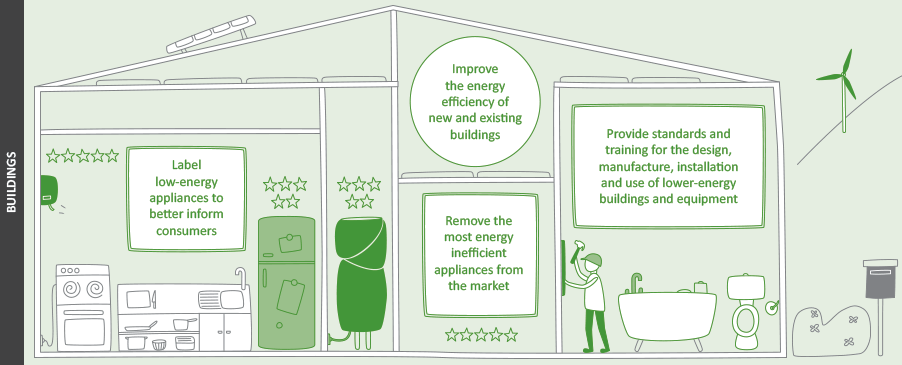Buildings
This section covers mitigation options for the building sector. There are many opportunities to reduce greenhouse gas emissions in the residential and commercial building sector. They include:
- Better energy management and improved minimum performance standards for appliances.
- Improving insulation levels; retro-fitting existing building stock; integrating renewable energy systems; and supporting innovative ‘green building’ design.
In pictures

- Actions we can take in the building sector now towards a low-carbon future for New Zealand

- Approximation of potential emission reductions in residential buildings

- Approximation of potential emission reductions in commercial buildings
Key findings
- The buildings sector is responsible for around 20% of New Zealand’s energy-related GHG emissions, mostly arising from the fossil fuels consumed to meet the demand for heating, cooling and electricity. The majority of buildings that will be in existence in 2050 have already been built so we need to concentrate on improving the performance of current building stock.
- The energy efficiency performance of existing buildings can be largely determined by the original design but tools to help improve performance are currently unavailable for most building types.
- Renewable heat options for buildings have high mitigation potential including wood pellet burners, ground source heat pumps, and passive solar systems.
- It is sensible to minimise the potential energy demand of new buildings at the design stage (such as orientation and solar system integration) otherwise they will have high energy demands for many years.
- The New Zealand Building Code clause on energy efficiency provides a minimum bottom line, and instruments such as Greenstar and NABERSNZ can help encourage new building developers and owners to aim higher.
- Government procurement policies are often a barrier to greater uptake of renewable energy technologies as they often do not consider choice based on a life cycle analysis.
- Appliances have shorter lives than buildings but can still be consuming energy 15 to 20 years after purchase. The application of minimum energy performance standards (MEPS) can help by removing the least efficient appliance designs from the market. ‘Doing better’ labels, such as EnergyStar, can help encourage manufacturers to supply more efficient appliances.
- Education and training for people designing, constructing, installing and using buildings and appliances is key to reducing GHG emissions over time.
- There is limited up-to-date knowledge on how energy is used in residential or commercial buildings in New Zealand so if this sector is to play a greater mitigation role, this knowledge gap needs to be addressed.
Read the summary
- Buildings, p15
Read the report
- Buildings, p112
- Sources of GHGs emissions
- GHG emissions profile and baseline trends for New Zealand
- GHG mitigation options
- Residential building energy use
- Commercial buildings' energy use
- Influence of long term ambitions on near term actions and pathways
- Co-benefits
- Case studies
- Knowledge gaps
